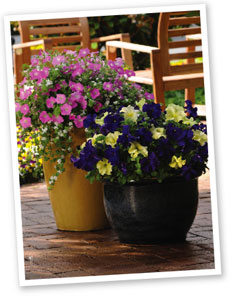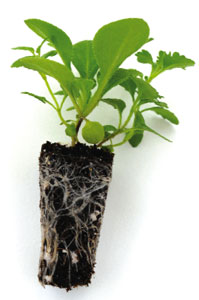10/25/2010
Instant Combos from Seed
Laurence Pallez

The demand for mixed-container recipes from home gardeners continues to rise. With its latest seed innovation, PanAmerican Seed makes it even easier for growers to produce exciting, more natural-looking combos in the greenhouse.
The new Fuseables line of multi-pellet seed is formulated to deliver a balanced mix of two to three varieties. This simple-to-grow seed germinates and grows compatibly for eye-catching mixes at retail.
Fuseables technology allows for single-species multi-pellets of early- and late-blooming lobelia for season-extended displays. It also takes the guesswork out of flower component selection by creating well-mixed petunia combos, as well as multi-species multi-pellets.
All Fuseables varieties were selected and tested for assured success. They’re economical, and crop time fits with normal bedding plant production. In this article, we’ll only discuss the multi-species multi-pellet aspect of Fuseables—mixing petunias with bacopa—in which one pellet makes one plug to grow one combo.
 Plug Production
Plug Production
We recommend sowing Fuseables multi-species multi-pellets in a 105/128-cell tray or larger, to accommodate the additional seedlings. Use well-drained, disease-free seedling medium with a pH of 5.5 to 6.0 without covering the seed. Be sure to use plenty of water after sowing to completely dissolve the pellet.
Germination takes about four days at a temperature of 72F to 76F (22C to 24C) with 100% relative humidity until radicles emerge. Level 5 water levels during Stage 1 make for optimal germination.
Slightly reduce soil moisture during Stage 2 to let roots penetrate the media. Apply a nitrate-form fertilizer with low phosphorous at rate 1 (less than 100 ppm N) at this stage, with light up to 2,500 f.c. (26,900 Lux).
In Stage 3, allow media to dry until the surface becomes light brown (level 2) before watering again at a wet-dry cycle (moisture level 4 to 2). Cooler temperatures in this stage at 65F to 70F (18C to 21C) will help with the competition amongst the multiple seedlings in each plug cell, and will provide natural growth control, so there shouldn’t be a need for PGR applications. If PGR application is necessary, do not use B-Nine applications at rates higher than 1,000 ppm for growth control during the plug stage as it could stunt bacopa, resulting in the spreading petunia dominating the plug cell.
The further cooling temperatures during Stage 4 will provide natural toning of the Fuseables plugs. Keep the moisture levels the same as Stage 3. Fertilizer levels should remain at rate 2 (100 to 175 ppm N/0.7 to 1.2 mS/cm EC). If growth is slowed, apply a balanced ammonium and nitrate-form fertilizer with every other fertilization.
Growing On
For containers sized 10 in. to 12 in. (25 cm to 30 cm), transplant three plugs per color bowl or basket. Multi-species Fuseables of petunia and bacopa can be finished at temperatures as low as 50F (10C). Crop timing is related to average temperature when grown under proper daylength. Plants will take longer to flower when grown under cooler conditions.
Light levels should be kept as high as possible while maintaining moderate temperatures. Fertilize at rate 3 with a nitrate-form, low-phosphorous solution every other irrigation. A Bonzi drench of 2 to 4 ppm works well for multi-species Fuseables petunia and bacopa plant size control.
Cotton Candy (a mix of Shock Wave Pink Vein petunia and Blutopia bacopa) is more vigorous than Silk N’ Satin (a mix of Shock Wave Pink Shades petunia and Snowtopia Improved bacopa). Cotton Candy can use the higher range of the Bonzi drench. Apply when foliage is close to reaching the edge of the container.
GT
Ms. Laurence Pallez is an assistant product manager for PanAmerican Seed Company in West Chicago, Illinois.